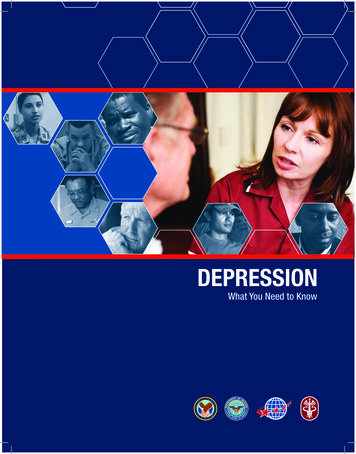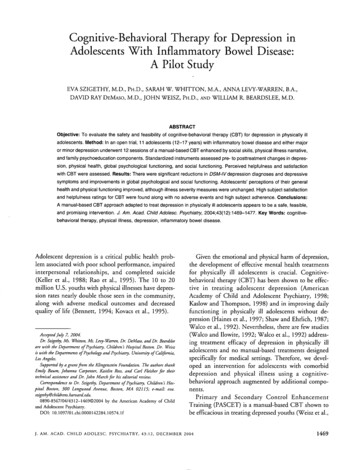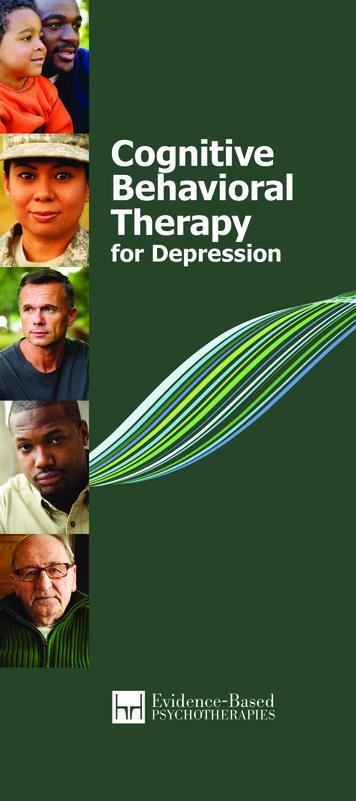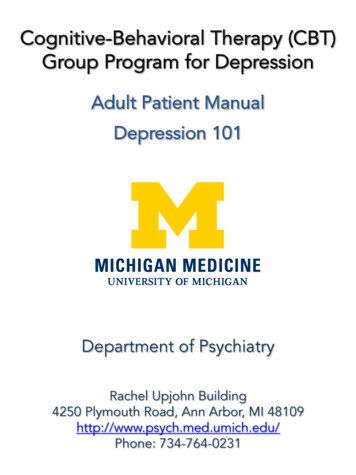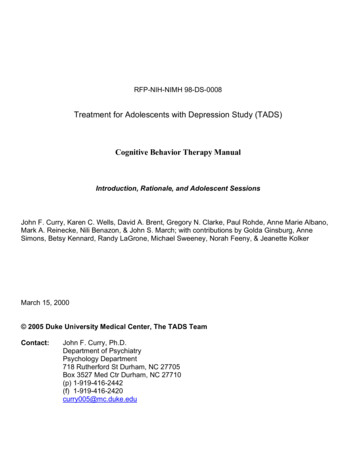
Transcription
RFP-NIH-NIMH 98-DS-0008Treatment for Adolescents with Depression Study (TADS)Cognitive Behavior Therapy ManualIntroduction, Rationale, and Adolescent SessionsJohn F. Curry, Karen C. Wells, David A. Brent, Gregory N. Clarke, Paul Rohde, Anne Marie Albano,Mark A. Reinecke, Nili Benazon, & John S. March; with contributions by Golda Ginsburg, AnneSimons, Betsy Kennard, Randy LaGrone, Michael Sweeney, Norah Feeny, & Jeanette KolkerMarch 15, 2000 2005 Duke University Medical Center, The TADS TeamContact:John F. Curry, Ph.D.Department of PsychiatryPsychology Department718 Rutherford St Durham, NC 27705Box 3527 Med Ctr Durham, NC 27710(p) 1-919-416-2442(f) 1-919-416-2420curry005@mc.duke.edu
Acknowledgements, Source Material and Background ReferencesThe TADS adolescent and parent/family session manuals were written with the support of NIMH contract98-DS-0008. In developing these manuals, we have relied upon existing treatment manuals that havebeen used successfully in the treatment of adolescent depression. We have also relied upon the activeinvolvement of co-authors who are experts in the treatment of this disorder in young people. SinceTADS is designed as an effectiveness study, it was important to base the cognitive behavioralintervention on earlier efficacy studies. The major adolescent studies were those conducted by DavidBrent and colleagues and by Peter Lewinsohn, Greg Clarke and their colleagues. These treatmentstudies applied cognitive behavioral therapies based on the seminal works of Aaron Beck and of PeterLewinsohn, to adolescent depression. David Brent generously provided to TADS his individual treatmentmanual for adolescent depression (Brent & Poling, 1997) to be used as background and context for theTADS CBT. This manual delineates key issues specific to the treatment of adolescents, critical findingsregarding the associated and complicating variables linked to adolescent depression, a clear descriptionof elements of a collaborative working relationship with the depressed adolescent, and developmentalphases in the cognitive therapy of adolescents. In the TADS project, CBT therapists are required to readthe Brent and Poling manual as a basis for TADS treatment, particularly the cognitive aspects of thetreatment.Greg Clarke, Peter Lewinsohn, Hyman Hops, and Paul Rohde (1990, 1999) have graciously permittedus to adapt concepts and techniques from their group cognitive behavioral treatment manual foradolescent depression. Among the key concepts adapted for use in the TADS overall treatmentrationale are the "triangle" model of the three parts of the personality, and the notion of downward andupward spirals. Among the techniques are methods to increase pleasant activities, to improve socialinteraction and communication skills, to generate positive, realistic thoughts about self, and to anticipateand plan to cope with post-treatment stress. With their permission, the TADS Teen Workbook includesthe “Triangle” and their form to monitor and increase pleasant activities.A third source for the TADS adolescent and complementary parent/family manuals were the group andfamily therapy manuals developed by Curry, Wells, Lochman, Nagy, and Craighead (1997) and Wells &Curry (1997) in an NIDA-funded study of depressed, substance abusing adolescents (DA-08931). Thispair of manuals was in turn based on adaptations from a number of sources including Clarke, Lewinsohn& Hops' (1990) group manual, Botvin’s (1989) Life Skills Training manual, and books by Beck, Rush,Shaw, and Emery (1979), Beck, Wright, Newman, and Liese (1993), and Wilkes, Belsher, Rush, & Frank(1994). The reader is referred to these sources for more extensive coverage of topics included in theTADS manual, at points where those topics are introduced.
Eva Feindler graciously permitted us to adapt sections on relaxation methods from her manual onAdolescent Anger Control (Feindler and Ecton, 1986). Michael Otto gave us permission to adapt his“Contrasting Coaches” metaphor related to parental expressed emotion (Otto, 2000). Arthur Robin gavepermission for us to reproduce part of his table on negative communication patterns in our Parent andFamily Sessions manual (Robin & Foster, 1989). Kathleen Carroll’s (1998) manual for the cognitivebehavioral treatment of cocaine abuse has served as a very valuable guide in clarifying CBT sessionstructure and manual organization for TADS. John March, Edna Foa, Marty Franklin, and MichaelKozak’s treatment manual for pediatric obsessive-compulsive disorder (1998) was helpful in articulatingthe role of parents in CBT directed toward treatment of their child’s disorder.The development of the TADS treatment manuals was an iterative and collaborative process. Themoderate degree of structure in TADS CBT, the integration of family sessions with individual adolescentsessions, and other fundamental decisions about the treatment were made in early 1999 by John Curry,Karen Wells, and John March, in collaboration with David Brent and Greg Clarke. Curry and Wells wroteinitial drafts of the adolescent and parent manuals, relying upon the source material noted above. Thesedrafts were then reviewed extensively by David Brent, Greg Clarke, John March, Mark Reinecke, PaulRohde, Nili Benazon, and Anne Marie Albano. Modifications were then introduced, based on thesereviews, prior to the TADS Feasibility study. Other site supervisors (Betsy Kennard, Randy LaGrone,Jeanette Kolker) contributed to decisions regarding “required” and “optional” components of the CBT.Further revisions and improvements were based on CBT supervisor conference calls during Feasibilityand on contributions made by the co-authors during a TADS project meeting in October, 1999. Amongmany examples, we list some of the major ones. Mark Reinecke contributed to the manual guidelinesfor fostering the therapeutic relationship and conducting intervention interviews. Paul Rohde contributedthe model of “tools in the backpack”, and the substance of the Week 12 session. Anne Simons andMichael Sweeney contributed to the integration of cognitive work within the treatment sequence, and tovarious methods for mood monitoring. Betsy Kennard, Golda Ginsburg, and Nili Benazon madesignificant contributions to the model of family intervention. Anne Marie Albano contributed the“contrasting coaches” model, based on Michael Otto’s work, for use with parents and adolescents andadditional treatment aspects pertinent to comorbid anxiety. John March kept the overall study design inthe forefront and helped to tailor the manuals to the Stages of treatment and intermediate transitions.Norah Feeny also contributed to scripting the transitions. These and other contributions were made inthe context of group discussions, under the leadership of the first two authors.We also want to acknowledge the assistance of those who helped with the final editing of the manuals,including Marla Bartoi, and with their production: Deborah Hilgenberg, Stuart Mabie, Patsy Martin, LindaRoberts, Marsha Brooks, and Deborah Bender.John F. Curry, Ph.D.Durham, NC
TADS CBT TREATMENT MANUALTheoretical and Empirical Foundations of TADS CBTSocial cognitive learning theoryCognitive behavior therapy (CBT) for adolescent depression is based on social cognitive learning theory.According to this model of personality and psychopathology, complex human behavior is based onprevious learning, especially the learning of social or interpersonal behavior and of central or corethoughts and beliefs. In addition to learning experiences based on operant (reward and punishment)and classical (association) conditioning, social learning is based on social reinforcement and modelingby significant others (Carver and Scheier, 1996). Social behaviors that reflect these learning processesinclude social communication and problem-solving (Alexander, 1973), and ways of relating to peers andauthority figures (Youniss and Smollar, 1985). Complex cognitions are also learned over the course ofdevelopment, including general expectancies for control and competence (Rotter, 1966; Bandura, 1977),attributional preferences or biases (Abramson, Seligman, & Teasdale, 1978), and schemas pertaining tothe self, other people, and the future (Beck, Rush, Shaw & Emery,1979).Because social cognitive learning processes involve both complex behaviors and complex cognitions,cognitive behavior therapy emphasizes both behavior change methods and cognitive informationprocessing methods to modify symptoms of disorders (March, 2000).Social Cognitive Factors in Adolescent DepressionA number of social cognitive factors have been demonstrated to characterize depressed adolescents.Depressed teenagers experience more negative automatic thoughts about self and others, lower selfesteem, greater hopelessness, and more cognitive distortions leading to misperception of events, thannon-depressed adolescents (Garber, Weiss, & Shanley, 1993; Haley, Fine, Marriage, Moretti, &Freeman, 1985). Weisz, Stevens, Curry, Cohen, Craighead, Burlingame, Smith, Weiss, & Parmelee(1989) found that low levels of perceived competence were particularly characteristic of depressedadolescents. In addition, depressed teens tend not to make internal, stable, global attributions to explainpositive events; but they do so for negative events (Curry & Craighead, 1990a; 1990b). Depression isthe diagnostic category most often associated with suicidal ideation and behavior in teenagers (Brent &Poling, 1997).In the social domain, depressed teenagers show deficiencies in participation in pleasant activities,sensitivity to negative stressful events, and more frequent perceptions of family conflict than nondepressed adolescents (Clarke, Lewinsohn, & Hops, 1990). Marital discord, high parental expectationswith low levels of
positive social reinforcement, and high parental criticism have also been found in families of depressedadolescents (Forehand, McCombs, Long, Brody, & Fauber, 1980; Cole & Rehm, 1986; Schwartz, Dorer,Beardslee, Lavori, & Keller, 1990).Cognitive Behavior TherapyCognitive behavior therapy addresses these social cognitive processes in the context of a therapeuticrelationship. Prior studies have shown that cognitive behavior therapy is effective in the treatment ofadolescent depression (Reinecke, Ryan, & DuBois, 1998). For instance, two studies by Lewinsohn,Clarke, and their colleagues (1990; 1999) demonstrated that a skills building psychoeducational course,with a strong emphasis on behavioral skills training, reduced depression significantly more than a waitlist control condition. A study by Brent and colleagues (1997) showed that cognitive behavioralintervention based primarily on Beck's model of cognitive therapy (Beck, Rush, Shaw, & Emery, 1979),with strong emphasis on recognizing and challenging maladaptive thoughts and beliefs, was effective forteen Major Depression.Recent reviews by Kazdin and Weisz (1998) and by Kaslow and Thompson (1998) concluded thatcognitive behavior therapy for adolescent depression was one of relatively few childhood or adolescenttreatments that met the criteria for at least probable efficacy as an empirically supported treatment.Kazdin and Weisz (1998) noted that such treatment is based on the view that depressed youngsters arecharacterized by: 1) negative cognitive processes; 2) a lack of important behavioral skills, particularlythose needed for social support and for affect regulation. Thus, in the present treatment program, wehave included both cognitive and more behavioral components.Kazdin and Weisz (1998) and Kaslow and Thompson (1998) have pointed out that components ofsuccessful cognitive behavioral interventions for depression in young people include methods:1.2.3.4.5.to increase participation in pleasant, mood enhancing activitiesto increase and improve social interactionsto improve conflict resolution and social problem-solving skillsto reduce physiological tension or excessive affective arousalto identify and modify depressive thoughts and attributionsIn addition, programs such as those of Brent and colleagues (1997) and Lewinsohn, Clarke andcolleagues (1990, 1999) include:1. mood monitoring2. goal-setting3. presentation of a clear treatment rationale and socialization of the adolescent and parents to thetreatment model based on this rationale.
Finally, Brent's model (Brent & Poling, 1997), the only model used thus far in a controlled treatment trialof individual cognitive behavior therapy for adolescent Major Depression, places great emphasis oncollaborative empiricism, the establishment of a trusting, open, and collaborative relationship betweenthe therapist and the adolescent. In the context of this relationship, depressive cognitions can beidentified, questioned, and challenged.SummaryTo summarize, the present treatment falls in the cognitive behavioral category of interventions because itincludes emphases both on cognitive processing and on amelioration of skill deficits in the socialbehavioral arena. It builds upon earlier work, and upon the reviews of successful studies by includingattention to domains that have been addressed in those studies. It requires that the therapistunderstand and communicate to the teen and the parents the model of depression and the model oftreatment for depression used over the course of sessions. (These are included in the manual and inthe Teen Workbook handouts for the initial Rationale and Goal-Setting Session). It requires that thetherapist establish, monitor, and maintain a collaborative therapeutic alliance with the teenager and theparents.The Therapeutic RelationshipAs is true for any psychotherapeutic intervention, TADS CBT can be conducted only within thecontext of a working alliance between the adolescent and the therapist. An alliance with the parentsis also necessary. At times the therapist who works with adolescents must maintain an alliance bothwith the teenager and with the parents in the face of conflict between the adolescent and the parents.Key requirements for CBT therapists include capacity for accurate empathy, warmth, genuineness,and rapport with diverse patients and parents. In addition, collaboration in setting the agenda forsessions, in testing the accuracy of cognitions, and in implementing “Homework” assignments withthe patient is essential for the conduct of CBT.Both Beck (1979, Chapter 3) and Brent and Poling (1997) have written about the therapeuticrelationship in cognitive therapy. In summary, the essential personal characteristics of the therapist,first described by Rogers (1951) are described below:Essential Characteristics of the Therapist1. Accurate Empathy: This refers to the therapist’s ability to take the patient’s perspective, seethings as the patient does, and understand the patient’s distress. The therapist recognizes andverbalizes an understanding of what the patient is feeling. Challenges to empathy withadolescents can occur when the therapist identifies with the patient (often against the parents),
sympathizes with (rather than empathizing with) the patient, or becomes irritable toward the(oppositional/angry) adolescent.2. Warmth: this refers to the therapist’s ability to convey a caring concern for the patient. Tone ofvoice, manner, phrasing of comments can all convey warmth. Challenges to warmth occur whenthe therapist is too demonstrative or active in conveying concern or too abrupt or distant. In theformer case, the teenager may perceive the therapist as lacking in genuineness, as notappreciating the negative aspects of the patient, or as “too close” emotionally. In the latter case,the teenager may feel rejected or “disrespected.”3. Genuineness: this refers to the therapist’s honesty with self and with patient. Genuinenessrequires self-awareness and self-monitoring on the part of the therapist. As Beck (1979) pointsout, genuineness must be accompanied by the ability to convey feedback to the patient withoutbeing too blunt or perceived as critical. Promises about “cure” or recovery can threaten thetherapeutic relationship on the grounds of lack of genuineness.In addition to characteristics of the therapist, characteristics of a positive therapeutic relationship,have been outlined by Beck (1979) and by Brent and Poling, 1997).Characteristics of a Positive Therapeutic Relationship1. Rapport: this refers to the therapist’s ability to establish “harmonious accord” (Beck, 1979, p. 51)with the patient. There is a lack of defensiveness on the part of each party, and the patient feelsaccepted (despite all his or her faults) by the therapist, and able to express himself or herselfwithout belaboring feelings, explanations or comments. Developing rapport is facilitated by thetherapist factors mentioned above, and by behaviors such as courtesy, timeliness, appearance,active listening, eye contact, tone of voice, and timing of verbalizations during sessions.Brent and Poling (1997) note other therapist initiatives that can facilitate the development ofrapport. The therapist can ask the teenager to discuss his or her interests, hobbies, or activities.During treatment the therapist should explain the rationale for specific interventions. In particularthe rationale for homework assignments needs to be explained, so that the teenager can see howthese might be of benefit to her or him.Rapport is also enhanced when the therapist explains any transitions in sessions introduced bythe therapist. These include changes of topic or agenda items under discussion, and shifts fromone part of the session to the next.
2. Collaborative empiricism: this refers to the therapist’s ability to “work with” the patient in lookingfor evidence regarding accuracy of thoughts, establishing the session agenda (Issues andIncidents), choosing and planning Homework. An active, interactive model of conducting sessionshelps to develop collaborative empiricism. The balance of activity and responsibility, however,changes over the course of treatment, with the therapist assuming more directive responsibilityearly and the patient assuming more over time.The Alliance with AdolescentsWilkes and Rush (1988) discussed issues of particular importance in the therapeutic alliance withadolescents. They warn against confronting dysfunctional thoughts too quickly duringtreatment. Particularly because adolescents tend to think in the here and now, and to be lessreflective upon their own thoughts than many adults, it takes more time for them to learn how to getperspective on their thoughts in an “objective” way. Challenging negative automatic thoughts tooearly in treatment risks damaging the alliance. These authors also recommended use of more activemethods, especially role-plays, and figural methods, such as drawings or charts, in addition to orinstead of traditional triple column or multiple column techniques. TADS therapists are expected touse role playing and/or modeling relatively frequently, and may use figural methods or otheractive methods as these seem appropriate for their adolescent patient. Hypotheticalscenarios, in the form of “letters from teenagers” are incorporated into the TADS manual asan example of a method that differs from some of the more typical CBT techniques.The therapeutic relationship with the resistant or angry adolescentMost adolescents do not enter treatment of their own volition. They are typically brought intotreatment by parents, sometimes at the urging of the school or social agencies. It is not at all unusualfor the adolescent to be angry about this, or to let the therapist know, often in non-verbal ways, thatthey are less than delighted to be present. It is critical at such times for the therapist to recognize andempathize with the adolescent’s feelings. This is often best done in an individual portion of thesession, after the parents have left the room. In such a setting, the teenager is free to discuss what isbothering her or him, and also free to relax and talk openly with the therapist without “losing face” infront of the parents. At any rate, angry or oppositional reactions to therapy or to the therapistmust be dealt with very early in treatment, by recognition, empathy, and active listening.
The Therapist’s Relationship with the Parents and Parental PsychoeducationThe therapist must also establish a cooperative, trusting relationship with the parents, and keep themapprised of the nature of the treatment and progress toward goals. The overall role of parents inTADS CBT is as members of a team that is joined together against a common enemy, theteenager’s depression. Parents in the TADS protocol meet with the therapist for psychoeducationalsessions, which include time devoted to obtaining the parents’ views about factors contributing totheir child’s depression. Interactive (conjoint) family sessions are also included so that familymembers can work together to identify and improve problem areas. At the time of individual sessionsfor the adolescent, TADS therapists may have a “check in” with parents for up to 10-15 minutes at thestart of the adolescent’s session. The adolescent should be present during this time. Finally, parentsare to be included as appropriate during the optional adolescent session on Affect Regulation, in theWeek 12, “Taking Stock” session, and in the Week 18 “Relapse Prevention” session.At the beginning of treatment, including a portion of the initial Rationale and Goal-Setting session andsubsequent psychoeducational sessions, parents are asked to indicate what may be contributing totheir teenager’s depression. Among the possible causal or maintaining factors, it is important toattend to parental beliefs and behaviors as possible social contexts for emergence of or maintenanceof adolescent depression. Any relevant parent-adolescent conflict, and any relevant parental beliefs,should be addressed during treatment. It is critical, however, to maintain the therapist-parentadolescent team approach, and to avoid blaming the parents for the adolescent’s depression.Common conflict-related issues in the families of depressed teenagers include high parentalexpectations and little positive reinforcement; negative (hostile, blaming, “zapping”) adolescent-parentcommunication; and marital distress between the parents. Other common issues are limited familypleasant activities, lack of conflict resolution (problem-solving and negotiation) skills, and parentalreinforcement of adolescent negative cognitions about the self, other people, or the future. Except formarital distress, all of these issues can be directly addressed during TADS sessions. Once the TADStherapist has an understanding about which of these areas may be salient for their particular case,they can focus family sessions on amelioration of those problem areas.The therapist should be alert, during the initial Rationale and Goal-Setting session, duringPsychoeducational sessions, and during other treatment sessions, to parental beliefs and attitudesthat can interfere with treatment progress. Since depression is often mystifying to observers of thedepressed individual, parents, like other observers, might be expected to fall into a number ofcommon traps. The first of these is the judgment that the adolescent is just
lazy, or could “pull himself/herself up by the bootstraps” with enough effort. In other words, theparents may think that the adolescent’s problems are intentional or under conscious control of theteenager. It is critical for the therapist to help the parents to understand that depression is a disease,and that the symptoms and associated dysfunction are not under the teenager’s control.Another belief that can interfere with treatment progress is the belief that depression is entirely abiological disorder and that only biological treatment is effective. The psychoeducational componentof TADS CBT includes discussion of the range of depressive symptoms and possible contributoryfactors. It is important to reinforce for the parent that depression is a biopsychosocial disorder, withsymptoms that affect biology, cognition, emotions, and social behavior. There is usually more thanone “cause” of a depressive disorder. Similarly, treatments that are biological and treatments that arepsychosocial have each been found to produce positive symptom change in the biological domain aswell as in the psychosocial domain.A third belief that can interfere with treatment progress is the belief that, once initial relief fromsymptoms is evident, active treatment is no longer necessary. Again, this can be countered byreinforcing the understanding that depression is an illness with a high rate of relapse or recurrence. Itis very important for the adolescent and parents to complete the full treatment program in order toobtain the skills needed to reduce the risk of relapse.Conjoint Family Sessions, Referrals for Treatment, and Sibling InvolvementTreatment of parental psychopathology or marital distress is outside the scope of TADS CBT for theadolescent. If the therapist makes a judgment that these problems are present, and especially if theyare having an influence on the depressed teenager (as would almost certainly be the case), referral ofthe parent(s) for their own treatment is indicated, and is not a protocol violation. All such referralsshould be discussed on the ASAP call, however, in order to determine whether an ASAP session isneeded to make the referral and in order to prevent systematic site biases in making referrals.Family sessions in TADS typically involve the parents and the depressed adolescent. The goal offamily work is to alleviate the teenager’s depression, and not to modify the family system as awhole. Siblings may be included in conjoint family sessions (but not psychoeducational parentsessions) under certain conditions. First, inclusion of a sibling is judged to be in the interest ofalleviating the adolescent’s depression. Second, the adolescent supports involvement of the siblingin one or more sessions. Third, the therapist makes the judgement that this does not represent anindirect way to obtain treatment for the sibling, or otherwise to shift the focus of TADS CBT from theidentified adolescent patient.
In general, a conjoint family session is one in which both the adolescent and the parent(s) are presenttogether for most of the session. There may be occasions in which the therapist makes the judgmentthat a conjoint session will be more productive if part is spent with the teenager alone, part with theparents alone, and part with all together. This may be quite reasonable, and may accurately mirrorclinical practice, but the general guideline in TADS is that at least half of such sessions should involveparent(s) and adolescent together. Requests for exceptions must be discussed on the CBTconference call.ConfidentialityConfidentiality is a major issue in the treatment of adolescents. The guidelines for confidentiality inTADS are presented in the material covered in the pre-treatment Gate C interview, and are includedin the study consent form. Essentially, the parents are advised of any dangerous behavior in whichthe teenager may engage (including suicidal thoughts, impulses, or activities), and are kept informedabout the nature of treatment, including what skills are being taught to the teenager, and aboutprogress toward goals. If parents call between sessions to talk with the therapist, the adolescent isinformed about this. Therapists are permitted and encouraged to “check-in” with parents at the startof individual CBT sessions for the adolescent for up to 10-15 minutes. This helps the therapist to beinformed about current concerns in the family and to assist the parents in positively reinforcing gainsmade by the teenager. In general the teenager should be present for this portion of the session toenhance open communication and trust.Working with adolescents and parents can lead therapists to experience conflicted loyalties andboundary problems. One is sometimes tempted to identify with the teen or, conversely, with theparent, in cases of family conflict. It is important to be clear about the overall goal of treatment(remission of the adolescent’s depression) and the proposed steps along the way to that goal. Thetherapist must maintain the stance of the adolescent’s therapist and not become an advocate for oneside against the other. Rules about confidentiality need to be clear to all parties at the outset. Thetreatment should be expected to enhance open communication rather than age-inappropriateindependence or secretiveness.Model of DepressionWithin the therapist’s manual for the initial Rationale and Goal-Setting Session and on the handout“What is Depression” in the Teen Workbook, there is a more extensive section on the followingpsychoeducational material, with suggestions for making it relevant to the teenager and parents:1. Depression is a disorder or disease that affects our mood and feelings, our behavior, our thoughts,and our physical condition. Although everyone has
times of sadness, irritability, or boredom, depression differs from these times because the sad orangry/irritable mood or the boredom is much worse, or goes on much longer. Depression(“moodiness”) is not something intentional that the teen can control or “snap out of.”2. Also, depression differs from these brief times of normal "bad mood", because it is associated withsymptoms. To fit within the model of CBT, symptoms are clustered on the adolescent’s handoutaccording to their primary experiential area. Symptoms are clustered as pertaining to Emotions (sad,irritable, bored, guilty), Thoughts (poor concentration, memory, decision-making; self-criticism; loss ofinterest; thoughts of death or suicide), Behavior (crying, avoiding people, slow movement oragitation, self-harm), or Biology (sleep disturbance; appetite or weight disturbance; fatigue; loss ofsex drive).3. Depression has many possible causes. These can include biological causes, such a
with a strong emphasis on behavioral skills training, reduced depression significantly more than a wait list control condition. A study by Brent and colleagues (1997) showed that cognitive behavioral intervention based primarily on Beck's model of cognitive therapy (Beck, Rush, Shaw, & Emery, 1979),


